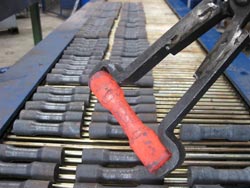IPH makes forging more efficient – on behalf of the EU

Forged preforms created by using cross wedge rolling must be further processed in order to obtain the final shape.<br><br>Source: IPH<br>
The german-based “Institut für Integrierte Produktion Hannover” (IPH) is working on the project together with two other research institutes and four enterprises from five European countries.
Whether producing engine parts, turbine blades or hip implants: Regarding forged parts, the material is the main component of the production costs, especially if a high duty material like titanium is used. During a new research project, IPH aims to develop a process in which less material is needed and which, at the same time, decreases time and energy consumption. This way, the researchers try to reduce the overall production costs significantly. Especially small and middle-sized forging enterprises will benefit from the results.
Die forging is forming of hot metal. To produce complex high duty parts, a single forging step is not enough to realize the complex shape. Therefore, so called preforms are produced during the forging process. To produce these preforms, different techniques are used. In most of the processes a lot of material gets lost: e. g. during machining a lot of excessive material is gradually removed – just like a sculptor removes excessive stone to expose the sculpture.
Cross wedge rolling (CWR) is the most efficient way to produce preforms. In this process the hot metal is formed into shape while rolling – just like a pottery maker is forming the figures by spinning the clay and forming it through gentle pressure.
The material utilization in cross wedge rolling is up to 100 percent. Also, less time and energy is needed, compared to machining. A lack of knowledge about the design of a cross wedge rolling process in general and especially for titanium and stainless steel is a main problem for the European forging industry. But particularly for these expensive materials an efficient material utilization has a great benefit.
To examine the cross wedge rolling technology, a titanium hip implant will be forged in the research project “CoVaForm”. The IPH has gained a lot of experience in cross wedge rolling during several research projects and will now build up a new CWR machine to produce preforms for a hip implant. This CWR machine will be tested at a collaboration partner by the middle of next year.
Funded by the EU, “CoVaForm” started January 1st 2014 and will last for a period of two years. The shortcut stands for “Conservation of valuable materials by a highly efficient forming system”. The project consortium consists of four enterprises and three research institutes from Germany, Spain, Italy, Austria and Turkey. This project is financially supported by the European Union as part of the seventh framework program (RP7).
The main interest lays in the help of small and middle-sized European forging plants to remain competitive in the international market and therefore help to secure approximately 68000 jobs – the number of people working in European forging plants in 2011. The overall sale in the sector was 12 billion Euros.
Companies who use forged parts for production will benefit in the long run due to more efficient forging processes and lower costs – first of all in the automotive industry, but also in the medical- and aerospace industries.
Media Contact
All latest news from the category: Machine Engineering
Machine engineering is one of Germany’s key industries. The importance of this segment has led to the creation of new university degree programs in fields such as production and logistics, process engineering, vehicle/automotive engineering, production engineering and aerospace engineering among others.
innovations-report offers informative reports and articles covering technologies such as automation, motion, power train, energy, conveyor, plastics, lightweight construction, logistics/warehousing, measurement systems, machine tools and control engineering.
Newest articles

Parallel Paths: Understanding Malaria Resistance in Chimpanzees and Humans
The closest relatives of humans adapt genetically to habitats and infections Survival of the Fittest: Genetic Adaptations Uncovered in Chimpanzees Görlitz, 10.01.2025. Chimpanzees have genetic adaptations that help them survive…

You are What You Eat—Stanford Study Links Fiber to Anti-Cancer Gene Modulation
The Fiber Gap: A Growing Concern in American Diets Fiber is well known to be an important part of a healthy diet, yet less than 10% of Americans eat the minimum recommended…

Trust Your Gut—RNA-Protein Discovery for Better Immunity
HIRI researchers uncover control mechanisms of polysaccharide utilization in Bacteroides thetaiotaomicron. Researchers at the Helmholtz Institute for RNA-based Infection Research (HIRI) and the Julius-Maximilians-Universität (JMU) in Würzburg have identified a…



